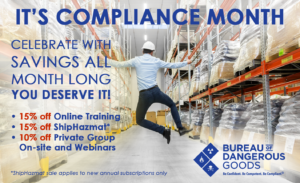When an emergency involving dangerous goods transportation occurs, first responders such as firefighters, paramedics, and police officers must be able to respond appropriately to the nature of the hazardous materials. It can be done safely and effectively when these first responders have been provided the necessary dangerous goods training and emergency response information.
Why Does Dangerous Goods Training Matter?
Consider a situation where a first responder is called to the scene of a crash involving dangerous goods that caused a fire. The first responder should be in a position to quickly identify the type of material that caused the fire, and the basic properties of that material. That way they can follow the correct emergency response.
For example, if a chemical is labeled/placarded as 4.3 – Dangerous When Wet, the first responder will proceed accordingly and not use water to extinguish a fire or chemical reaction related to this substance. Dangerous goods training for marking, labeling, and shipping paper preparation, prepares the shipper to compile accurate shipment information which will provide the responder in this situation with crucial details to protect the public, property, and themselves.
Compliance With CIPC For Hazmat Transportation
During the transportation of dangerous goods, compliance with the following CIPC requirements is vital. Equally important is that the emergency responders must have the appropriate level of dangerous goods training related to CIPC as well:
- Classification
- Identification
- Package and Packing
- Communication (Marking, Labeling, Shipping Papers, Segregation, Placards)
To begin with, hazmat employees responsible for CIPC functions must have the right dangerous goods training to classify, identify, pack, and communicate about the hazardous materials correctly. On the other hand, the emergency responders must also have dangerous goods training to be able to interpret and follow the CIPC line of reasoning correctly.
Classification And Identification They Go Hand In Hand
When dealing with dangerous goods transportation, the distinctions between classification and identification must be clearly understood. The hazardous material to be transported must be classified according to its hazard class and the level of risk it poses during transportation.
Identification of dangerous goods, on the other hand, involves assigning correct shipping names and UN/ID numbers to the dangerous goods according to their composition and classification. It is important to understand that different types of dangerous goods have different properties. These properties may need to be uniquely identified so that if an emergency occurs the materials can be treated appropriately.
Hazmat Packaging, Labels, And Markings
Dangerous goods training ensures that dangerous goods packages have proper hazard class labels and marks that meet regulatory requirements. These dangerous goods identifiers indicate the type of hazard and are placed in their designated location on the package. The dangerous goods packaging itself must also be in compliance with the prescribed regulations.
If the emergency responders are not trained to know where the identifiers are placed on the package and interpret the dangerous goods documentation and what hazards they indicate, it could defeat the purpose. When the first responders are required to fight a fire, perform an evacuation, or carry out a chemical spill clean-up, their dangerous goods emergency response training will make all the difference.
Undergo Dangerous Goods Training With Hazmat University
Hazmat University is one of the leading providers of online dangerous goods training in compliance with federal as well as international regulations. Whether you are a hazmat employer, employee, or an emergency responder dealing with incidents related to dangerous goods transportation, you can benefit from Hazmat University’s online courses. For more information, call us at (844) 329-5618 or fill out this online form today.
Be confident – Be competent – Be compliant
